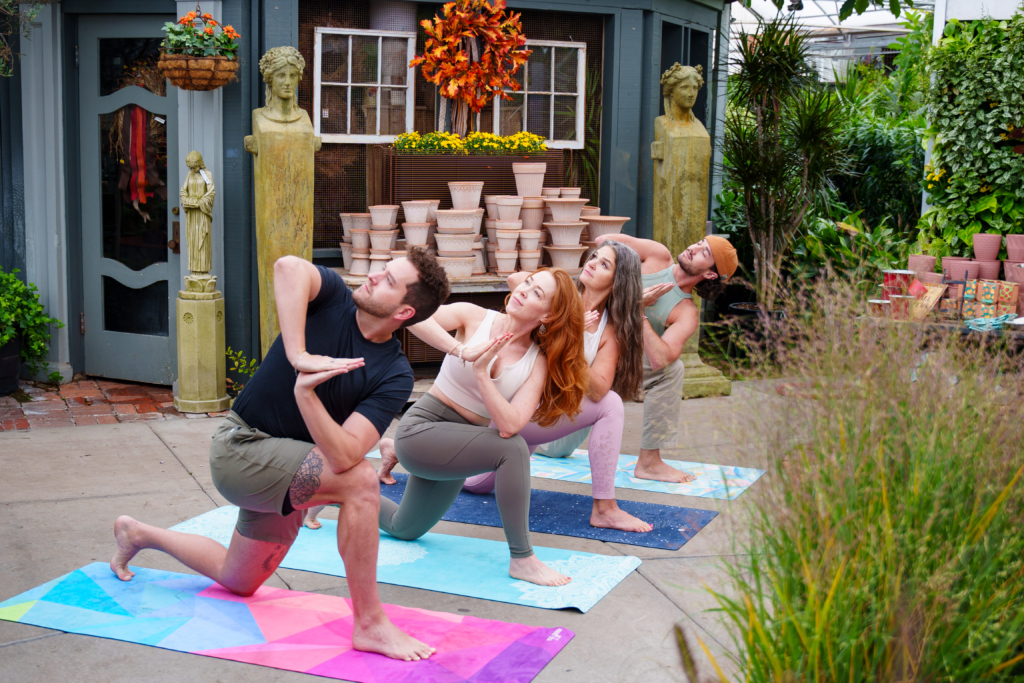Revolved Lunge Pose: Parvrtta Anjaneyasana

Why is Lunge Pose (Anjaneyasana) such a yoga practice staple? Lunge poses, in all their variations, are core to vinyasa practices and Hatha practices alike. Anjaneyasana lends itself to lots of different variations. There are high lunges and low lunges, forward bending and backbending lunges. And there are several forms of Revolved Lunge Pose (Parvrtta Anjaneyasana). Combining Lunge Pose with spinal rotation is, quite simply, a winning combination.
Lunge Pose is a powerful way to counteract the effects of habitual sitting. I’ve found that Lunge Pose is the most accessible way for my students to stretch their hip flexors, muscles that can shorten over time if when we sit all day long. Because the bend of the back knee is fairly open, people with range-of-motion issues in their knees can practice pain-free lunge poses.
Likewise, sitting and bending over keyboards, counter tops, steering wheels, etc., can cause our thoracic spines to begin to curve forward over time. Practicing twisting yoga poses helps keep our thoracic spines supple. Rotating the spine is one way to release tension in the soft tissue around the spine and increase our general mobility, particularly in the upper body. Twisting stimulates circulation, especially in the muscles, fascia and organs of the abdomen and thorax. Spinal rotation also compresses our internal organs to stimulate digestion.
How We Twist
It’s important to understand where rotation actually takes place in the spine. A popular alignment “rule” instructs you to keep your hips squared while twisting in order to create more of a twist in the lumbar spine. Unfortunately, because the facet joints in the lumbar spine prevent that section of the spine from twisting more than 1 to 2 degrees, the result of this action, over time, is to cause the sacroiliac (SI) joint to bear the twist. Rotation of the SI joint can, over time, destabilize the joint and cause dysfunction, which can cause a number of painful conditions, such as sciatica.
The thoracic spine, the part connected to the ribcage, is designed for rotation. So when you twist, keep in mind that this is where you should focus your efforts. Rather than keeping the pelvis squared in twists, allow it to move in the direction of your intended rotation, while focusing the twist in the thoracic spine.
Parvrtta Anjaneyasana is a great pose to explore this concept because your hips have lots of room to move.
How to Practice Revolved Lunge Pose
Gather your props: a Yoga Mat and a folded Yoga Blanket (optional) for under your knees.
How to Approach Revolved Lunge Pose
- There are several ways to enter a Lunge Pose. You can approach it from Tabletop Pose (Bharmanasana) by simply stepping your left foot forward. You will be bearing weight on your right knee and left foot.
- You can also start in Downward Facing Dog Pose (Adho Mukha Svanasana). From Dog Pose, extend your left leg up toward the sky, then swing the leg forward, setting your foot down in between your hands.
- You can also start from Mountain Pose (Tadasana). Fold forward into Standing Forward Bend (Uttanasana). Bend your knees so that you can place both hands on the floor next to your feet. Step your right leg back three or so feet, so that your left shin is vertical. Place your right knee on the floor.
Add a Twist
- From Lunge Pose, with your right knee on the floor and the left foot between your hands, lift your torso to an upright position.
- Rotate your torso toward the left leg. Lengthen your torso as you rotate, allowing your pelvis to rotate along with the torso. Your left hip will be higher than your right hip.
- Keep your right leg active. Extend back through your right heel.
- Place your right elbow on the outside of your left thigh. If this causes your breathing to become restricted, lift up a little higher, and place your right hand on the outside of your left thigh instead.
- If your elbow is on the outside of your thigh, as in the photo at the top of this post, place your hands together in front of your chest in Anjali Mudra (Prayer Position).
- Breathe and relax. You may feel that your torso wants to move in and out of the twist as you exhale and inhale. Relax your pose enough so that you can feel your body oscillate in rhythm with your breath.
- Take 5 to 10 deep breaths.
- Unwind, turning the torso back so that it’s resting over your left leg.
- Return to Tabletop Pose, Downward Facing Dog Pose or Standing Forward Bend Pose. Relax here for a few breaths to feel the effects of Revolved Lunge Pose.
- Repeat on the other side.
